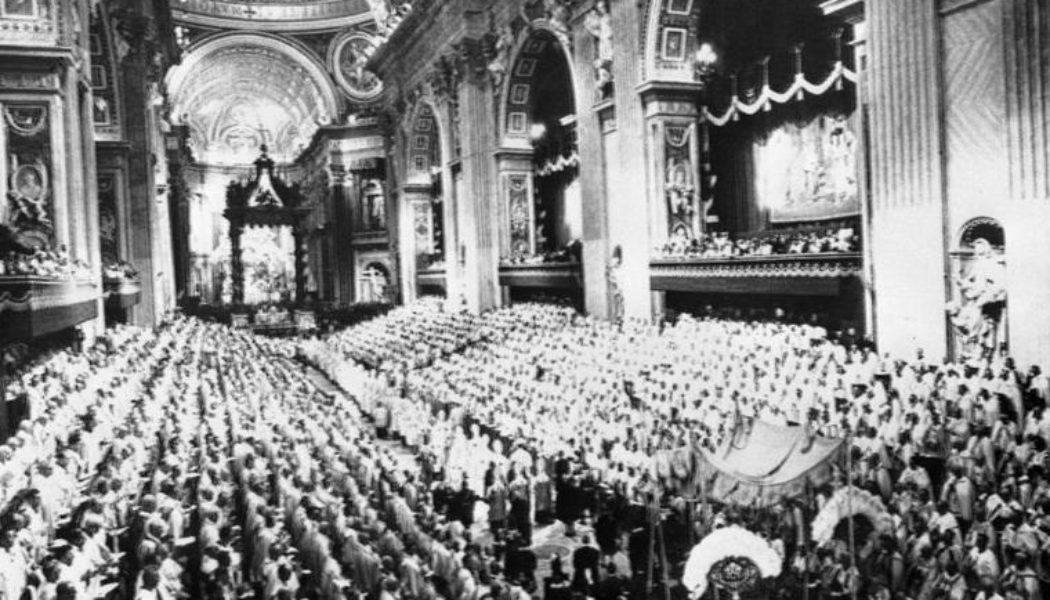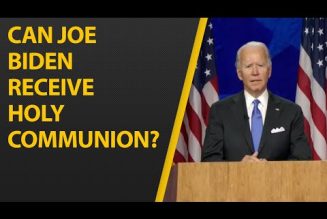
Editor’s Note: This article is part of the Register’s symposium on Vatican II at 60.
The Latin title of the Second Vatican Council’s pastoral constitution on the Church in the modern world, Gaudium et Spes (Joy and Hope), is not misleading, as it sets out to be both joyful and hopeful, not seeking conflict or confrontation, totally avoiding the use of any anathemas. It is described as a pastoral constitution and was a novelty in conciliar history. I am unsure it will ever be attempted again by a full council, however that may occur with more than 5,000 bishops.
While being doctrinally based on the conciliar documents on the Church, Lumen Gentium, and Revelation, Dei Verbum, this constitution is not primarily doctrinal, but sets out a vigorous Christocentric humanism, guidelines on how the Catholic community should relate with the modern world, in its bewildering variety. It is something of both a commentary and an exhortation and could be described as sociological or prudential, rather than dogmatic.
One can understand what the Council was doing and what needed to be done. Dating back to the Council of Elvira in 306, when offenders had been separated from the body of the faithful, the Church had protected the faith and promoted the common good through the issuance of anathemas and other similar measures, such as the “Index of Forbidden Books,” first published in 1557. These ecclesial efforts were often aided by the alliance between altar and throne, begun by Constantine in the fourth century, and begun again in the Holy Roman and Germanic Empire with the crowning of Charlemagne in St. Peter’s in A.D. 800.
But dynamics began to change in the early modern period. The Reformation first divided Christendom, while the Augsburg formula of the Peace of Westphalia in 1648, cuius regio, eius religio, formally recognized that each state would be either Catholic or Protestant. The French Revolution created the real possibility that some states in Europe might even be actively hostile to the Christian faith. Pope Leo XIII, especially in the 1891 encyclical Rerum Novarum, had begun the process in which the papacy came to terms with industrial democracy, which was already further advanced in the English-speaking world, unencumbered by memories of a Catholic alliance of throne and altar. For Catholics in those places, the crown had been a persecutor.
As the papal representative in Bulgaria, Turkey and post-World War II France, Archbishop Angelo Giuseppe Roncalli, the future Pope John XXIII, realized the “ancient regime” had gone forever, and Gaudium et Spes reflected this. Although it was less than 20 years after the terrible Second World War, the pastoral constitution reflected the optimism of a reconstructed Western Europe, put together by Christian statesmen, such as Alcide de Gasperi, Konrad Adenauer and Robert Schuman, protected by American military might and regaining its prosperity.
The first part of the constitution is theological, dealing with the dignity of the human person, the community of mankind, and man’s activity in the universe. We find useful sections on conscience and freedom, the common good, the importance of reconciling science and religion, the good things the Church offers and receives from the world, and a Teilhardian section on Christ as the Alpha and Omega.
A long section on atheism contains the only mention of communism in the Council documents, although the Soviet Union is not named; instead, the document laments that some atheists “violently attack religion” and indoctrinate the youth in their schools when they achieve political control (GS, 20). The common view is that the conciliar silence on communism, the absence of condemnation, was the agreed price for the presence of bishops from communist Europe and for the presence of observers from the Russian Orthodox Church. At least the first of these brought important blessings.
But the silence on communism that was actively persecuting Christians throughout Eastern Europe, Russia and China skewed the Council’s perspectives. The struggle between good and evil, which is at the heart of the Gospel, exemplified in the killing of our Redeemer, the constant menace and intrigues of the Evil One, the struggle between the Light and darkness (John 1:4-5) and the hatred of the world for Christ and his followers (further spelled out in John’s Gospel, 15:18-19) — this dimension is somewhat lacking, especially in this document. The clash between the two standards of St. Ignatius of Loyola’s Spiritual Exercises is muted here.
When the menace of evil is understated or thought to be understated, we are further disadvantaged in our struggle “to discern the signs of the times,” a theme from Gaudium et Spes that is too often separated from its deeper theological context, serving as a pretext for conforming Christian truth to the erroneous precepts of our present age. Engagement with modernity is a start, but the signs are often evil, not evidence of God’s providence. Gaudium et Spes’ reminder of our duty to scrutinize these signs cannot ever be separated from its insistence that this can only occur “in the light of the Gospel” (GS, 4). The more difficult but vitally important task is to recognize the presence and activity of the Spirit and then pray for the wisdom to build constructively in the confusion.
Part Two concludes the document with treatments of marriage and the family, the proper development of culture, economic and social life, the political community, the fostering of peace, and establishing the community of nations. There is a section on war, the possibility of nuclear war and the arms race. All of these are high-quality contributions to the dialogue among people of goodwill, but to my mind overestimate our capacity to participate as equals with the more powerful hostile forces around us, present in every society and certainly in the contemporary West. They did not offer an ideal preparation for the culture wars, which have seen the dismantling of the Judeo-Christian legal foundations of marriage, life and family in many countries. Pope Paul VI’s 1968 Humanae Vitae was more prophetic, with more accurate insights into what lay ahead. Mission and struggle are more important than dialogue, but each has its proper time and place.
I think Hans Urs von Balthasar, back in 1952, was quite mistaken to see the demolition of the bastions of Catholicism — the secondary structures and patterns that the Church has built up throughout the ages — as a long-overdue task. Some, perhaps many, bastions are gone forever, but we need all the sociological supports we can find or construct. The contributions of Trump, or Orban, of the Fratelli d’Italia are not to be rejected, small as they might be, just as some of us remain grateful for Constantine and Charles V. It is not a mortal sin to dream of a Chinese Constantine or tolerate the status of the Anglicans in England.
The 21 councils in Catholic history are examples of the Holy Spirit at work, of divine Providence, despite and through their inadequacies as well as through the obvious benefits they produced. But they have not been held too frequently. Neither should synods become too frequent, become a competitor with prayer, worship and service. And history reminds us to be careful, not to build up false expectations, not to unleash forces which can escape our control.
The synodal process has begun disastrously in Germany, and matters will become worse unless we soon have effective papal corrections on, for instance, Christian sexual morality, women priests, etc. We find no precedents in Catholic history for the active participation of ex-Catholics and anti-Catholics in such bodies. Only the Council Fathers, almost entirely bishops, could vote at Vatican II, and the observers were all Christians. Pope St. Paul VI respected the authority and independence of the Council Fathers, intervening rarely as they laboriously produced their documents, established consensus, while remaining fully respectful of the magisterium and Tradition. Despite all this care and scholarship, and largely for reasons outside Church control, the post-conciliar story has not been one of glorious success.
Every synod has to be a Catholic synod, bound by the apostolic Tradition, just as Councils are so bound. To allow serious heresies to continue undisturbed is undermining and damaging the unity of the One, True Church, and again, is not consistent with Gaudium et Spes’ call for engagement with the modern world in “the light of the Gospel,” but contrary to it. There can be no pluralism of important doctrines of faith or morals. Our unity is not like that of a loose Anglican federation or that of the many national Orthodox Churches.
Some faithful German Catholics are already talking, not of the synodal way but the suicidal way. We must work and pray they are wrong, that no such disaster occurs anywhere in the Church in the modern world. Pope St. Paul VI was fair and even-handed and guided the Council well, creating a good and encouraging model; but the aftermath provides a warning of the powerful hostile forces that surround us.
Cardinal George Pell is an Australian cardinal of the Church who served as prefect of the Vatican’s Secretariat for the Economy between 2014 and 2019 and was a member of the “council of cardinals” between 2013 and 2018.
Join Our Telegram Group : Salvation & Prosperity








